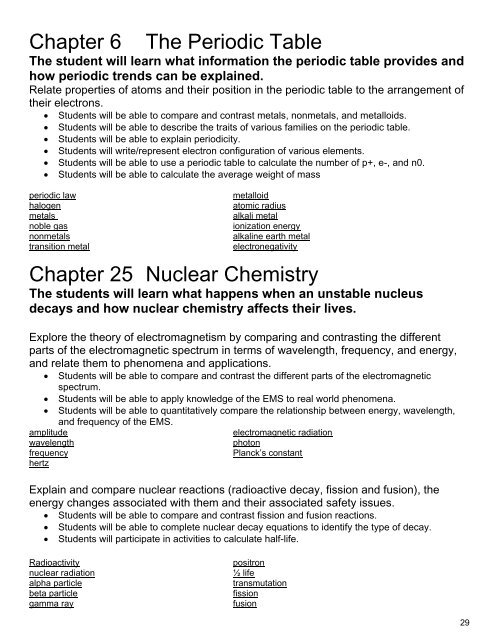Create successful ePaper yourself
Turn your PDF publications into a flip-book with our unique Google optimized e-Paper software.
Chapter 6<br />
The Periodic Table<br />
The student will learn what information the periodic table provides and<br />
how periodic trends can be explained.<br />
Relate properties of atoms and their position in the periodic table to the arrangement of<br />
their electrons.<br />
Students will be able to compare and contrast metals, nonmetals, and metalloids.<br />
Students will be able to describe the traits of various families on the periodic table.<br />
Students will be able to explain periodicity.<br />
Students will write/represent electron configuration of various elements.<br />
Students will be able to use a periodic table to calculate the number of p+, e-, and n0.<br />
Students will be able to calculate the average weight of mass<br />
periodic law<br />
halogen<br />
metals<br />
noble gas<br />
nonmetals<br />
transition metal<br />
metalloid<br />
atomic radius<br />
alkali metal<br />
ionization energy<br />
alkaline earth metal<br />
electronegativity<br />
Chapter 25 Nuclear <strong>Chemistry</strong><br />
The students will learn what happens when an unstable nucleus<br />
decays and how nuclear chemistry affects their lives.<br />
Explore the theory of electromagnetism by comparing and contrasting the different<br />
parts of the electromagnetic spectrum in terms of wavelength, frequency, and energy,<br />
and relate them to phenomena and applications.<br />
Students will be able to compare and contrast the different parts of the electromagnetic<br />
spectrum.<br />
Students will be able to apply knowledge of the EMS to real world phenomena.<br />
Students will be able to quantitatively compare the relationship between energy, wavelength,<br />
and frequency of the EMS.<br />
amplitude<br />
wavelength<br />
frequency<br />
hertz<br />
electromagnetic radiation<br />
photon<br />
Planck’s constant<br />
Explain and compare nuclear reactions (radioactive decay, fission and fusion), the<br />
energy changes associated with them and their associated safety issues.<br />
Students will be able to compare and contrast fission and fusion reactions.<br />
Students will be able to complete nuclear decay equations to identify the type of decay.<br />
Students will participate in activities to calculate half-life.<br />
Radioactivity<br />
nuclear radiation<br />
alpha particle<br />
beta particle<br />
gamma ray<br />
positron<br />
½ life<br />
transmutation<br />
fission<br />
fusion<br />
29




